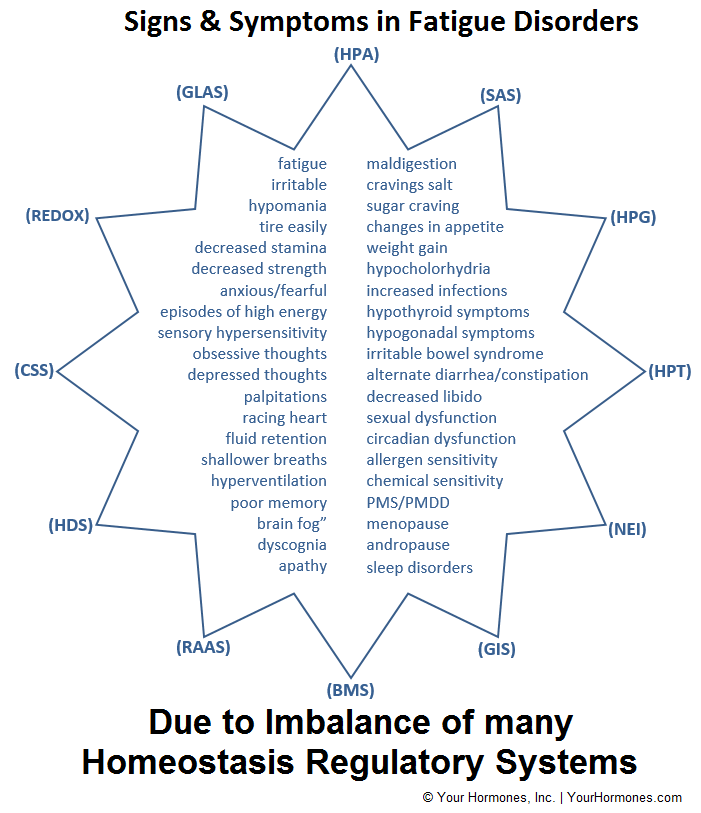Signs & Symptoms of "Adrenal Fatigue" by Joseph J Collins, RN, ND
To fully understand the broad range of symptoms that can be seen in "adrenal fatigue" we must first remember that we are talking about fatigue of multiple systems. If you are going through this series of articles in order, you will have seen that the homeostasis systems page describes the different homeostasis regulatory systems are all affected by stress, and that may be affected to the point that it results in a fatigue disorder. Keeping that point in mind, we can realize that signs and symptoms of fatigue disorders may be due to and imbalance (or allostasis) in any one or more of the different homeostasis regulatory systems.

As noted, homeostasis literally means “similar state”, in which body function are ideal. When a system is out of balance it is in allostasis, which means “different state” – things are not ideal. And most signs and symptoms are due to allostasis many different homeostasis regulatory systems. So in reality, fatigue may be caused by allostasis in any one or more of the of the following homeostasis regulatory systems:
Hypothalamic-Pituitary-Adrenocortical (HPA) axis
Sympatho-Adrenomedullary System (SAS)
Hypothalamic-Pituitary-Gonadal (HPG) axis
Hypothalamic-Pituitary-Thyroid (HPT) axis
Neuro-Endocrine-Immune (NEI) system
Glucose-Insulin System (GIS)
Brain Monoaminergic System (BMS)
Renin-Angiotensin-Aldosterone System (RAAS)
Hepatic Detoxification System (HDS)
Cellular Signaling Systems (CSS)
REDuction-OXidation System (REDOX)
Ghrelin-Leptin-Adiponectin System (GLAS)
Multiple Causes of Symptoms
We know that multiple systems are affected by stress. We know that multiple systems become stressed to the point that homeostasis is lost, allostasis sets in, and multiple symptoms associated with fatigue become evident. Knowing that multiple systems are effected by stress we can then understand that the symptoms of stress are not due to any one system.
The symptoms of fatigue disorders are in fact caused by the effect of multiple systems.
With that in mind, we can picture all the symptoms caused by fatigue disorders clustered together and surrounded by all the systems that are supposed to maintain homeostasis, but are instead in varying degrees of allostasis, resulting in fatigue disorders. Since fatigue is a symptom that occurs with allostasis in any one of the homeostasis regulatory systems. As noted, one of the first things that experienced clinicians realize when they are treating patients with fatigue disorders is that it’s not just adrenal fatigue. In fact, the symptoms that have been associated with adrenal fatigue are common in most chronic conditions, as well as many acute conditions in which the body cannot adapt to the acute stressor. What we have been seeing is multiple systems being affected by stress. This is what Dr Hans Selye called generalized adaption syndrome, which we recognize as fatigue disorders. These fatigue related symptoms are usually due to more than one of the homeostasis regulatory systems being imbalanced, and in allostasis. In a majority of cases, that the symptoms in fatigue disorders are due to multiple causes.
Since fatigue is a symptom that occurs with allostasis in any one of the homeostasis regulatory systems. As noted, one of the first things that experienced clinicians realize when they are treating patients with fatigue disorders is that it’s not just adrenal fatigue. In fact, the symptoms that have been associated with adrenal fatigue are common in most chronic conditions, as well as many acute conditions in which the body cannot adapt to the acute stressor. What we have been seeing is multiple systems being affected by stress. This is what Dr Hans Selye called generalized adaption syndrome, which we recognize as fatigue disorders. These fatigue related symptoms are usually due to more than one of the homeostasis regulatory systems being imbalanced, and in allostasis. In a majority of cases, that the symptoms in fatigue disorders are due to multiple causes.
Some of the many symptoms associated with adrenal fatigue and generalized adaption syndrome include generalized fatigue, irritable, hypomania , tire easily, decreased stamina, decreased strength, anxious/fearful, episodes of high energy , sensory hypersensitivity , obsessive thoughts, depressed thoughts, palpitations, racing heart, fluid retention, shallower breaths, hyperventilation, poor memory, brain fog”, dyscognia , apathy, maldigestion, cravings salt, sugar craving, changes in appetite, weight gain , hypocholorhydria , increased infections, hypothyroid symptoms, hypogonadal symptoms, irritable bowel syndrome, alternate diarrhea/constipation, decreased libido, sexual dysfunction, circadian dysfunction , allergen sensitivity, chemical sensitivity, PMS/PMDD, menopause, andropause and sleep disorders.
Treating the Multiple Causes of Symptoms
In fatigue disorders, multiples systems are no longer in homeostasis. The body is trying to adapt to the stressors and the systems end up in varying states of allostasis. Lifestyle changes such as proper diet, rest, hydration, and basic nutritional support are the first step to restoring homeostasis. These fundamental points are discussed in detail in the Foundations of Hormone Health article, which part of the Hormone Health series of articles. After addressing the fundamental points, the next consideration is to use herbal therapies that help the body adapt to stress.
Introduction to Adaptogens
The herbs that are most effective in helping the body adapt to stress are conveniently called “adaptogens”. The most popular of adaptogenic herbs are what all used to be called ginseng herbs. There was Chinese Ginseng, Siberian Ginseng and Indian Ginseng. However, these major adaptogens are not related, and come from different botanical families. Their proper names are Panax ginseng, Eleutherococcus senticosus, and Withania somnifera, respectively. These famous adaptogens, as well as other plants that are widely recognized as adaptogens, typically help many of the homeostasis regulatory systems adapt to stress. Panax ginseng support at least ten of the homeostasis regulatory systems. Eleutherococcus senticosus supports at least nine and Withania somnifera supports at least eleven of the twelve homeostasis regulatory systems we have discussed so far. I consider herbs that support a majority of the multiple homeostasis regulatory systems to be major adaptogens.
In addition, a number of other plants are found to have a few adaptogens properties, in which they may help one or more of homeostasis regulatory systems. I consider herbs that support a minor number of the homeostasis regulatory systems to be minor adaptogens. In my experience, and review of published research, many of these minor adaptogens” support six or more of the homeostasis regulatory systems.
Next: Learn more about Adaptogenic Herbs
Learn how to order AdrenoMend™
